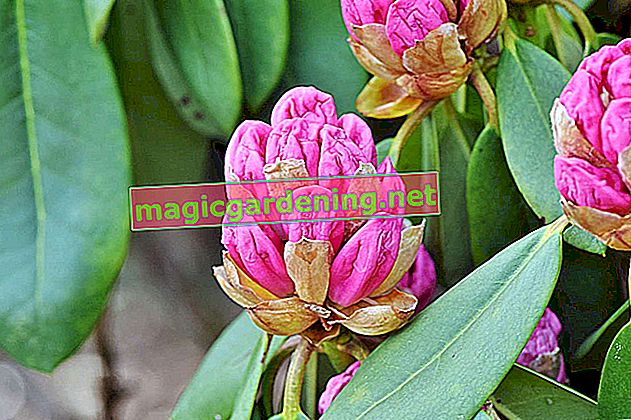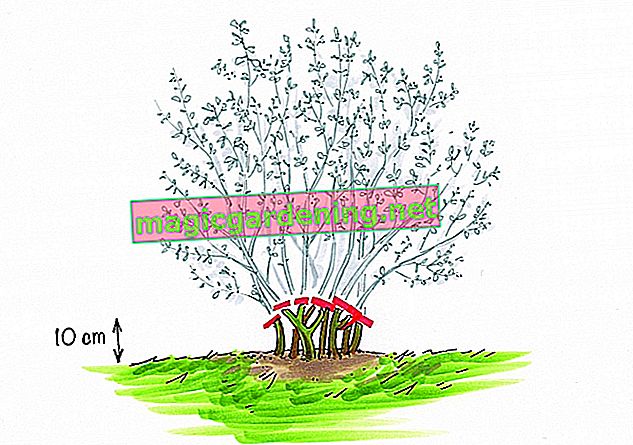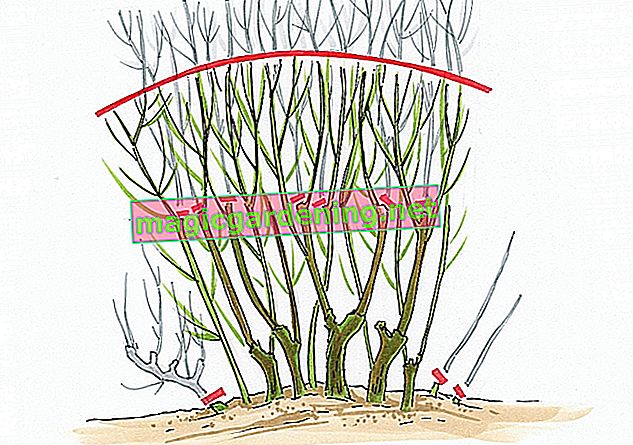
In the natural garden, gorse thrive uncut
All gorse bushes are a welcome source of food for bees, bumblebees and butterflies thanks to their early flowering period. The ornamental trees shine in all their splendor when valuable pollinator insects are dependent on nutritious nectar after the winter rest in order to draw strength for the development of their colonies. For ecologically minded gardeners, gorse bushes are part of the basic equipment when they create a natural garden.
also read
- When should I cut my gorse?
- When does the gorse bloom?
- What is the best location for gorse?
In the near-natural garden , gorse bushes of both types are allowed to grow freely . The reason for the horticultural decision is that the trees are not particularly pruning compatible. Either there is cut every year or not at all. The trees no longer sprout from old wood. An annual cut promotes the growth of young shoots, but leads to an unnatural, formally shaped shape. Uncut gorse develops a natural habitwith high utility for insects and birds. At the same time, the bushes sow themselves. Since gorse species are short-lived trees anyway, some seedlings are simply spared when weeding. If the parent plants die, the offspring will long have filled the gap.
Gorse cut at a glance - all cut types and dates
You cannot identify real gorse by its golden yellow flower clusters alone. In contrast to broom broom or noble gorse of the Cytisus genus, which also bloom yellow up to 2 meters high, real gorse bushes remain well below 100 meters high. The flowering period is another indication of the right pruning at the best time. Spring-blooming Cytisus species bloom on the wood of the previous year and are pruned immediately after the blooming period. Summer-flowering Genista species bloomthis year's shoots ** and are cut in early spring. If you are not familiar with the botanical classification of your broom, you can use the height and flowering time to decide which pruning types and dates in the following table apply to your flowering bush:
| Cut type | Gorse species (average height) | Heyday | best date |
|---|---|---|---|
| Plant pruning | all gorse | irrelevant | immediately after planting |
| Conservation cut | Real gorse and others (40 to 80 cm) | May / June to August / September | every February |
| Conservation cut | Broom gorse and others (100 to 200 cm) | April / May to June / July | every year after the flowering period |
You will look in vain for an appointment for the rejuvenation cut in this table. Gorse does not tolerate cutting into old wood. For this reason, pruning of gorse bushes only has a chance of success if it begins on the day of planting and is carried out annually.
For a better understanding of this tutorial, the repeated listing of the gorse species in question is dispensed with below. Real gorse includes the cut for all genista species, such as dyer's gorse, winged gorse, goldland gorse and sand gorse. Broom gorse represents species of the genus Cytisus, such as ivory and noble gorse, as well as the varieties derived from them.
Plant pruning encourages gorse to branch out vigorously
The pruning of gorse bushes begins on the day of planting . A plant cut has set itself the goal of motivating the young wood to branch densely from below. The following cut applies to real gorse and varieties as well as broom gorse and varieties:
- Immediately after planting, cut back all shoots to a height of 10 to 15 centimeters
- Shorten bare-root products by at least half, pot products by at least a third
- Cut off damaged and noticeably weak shoots at the base
- Examine bare-root young shrubs for damaged roots in order to cut them out
They give the flowering shrub a decorative, hemispherical shape when you cut at different depths. Shorten the outer shoots to 10 centimeters, whereas the shoots in the center are cut to 13 to 15 centimeters.

background
Plant cut redirects sap pressure to the base
In every gorse bush, the pressure of the sap acts as a control center for growth. The floral direction goes towards the light in order to stay ahead of the competition with neighboring plants. As a result, the majority of the reserve substances are heading towards the tip buds . This is where the strongest growth takes place. This applies equally to the plant itself and to each individual shoot. The greater the distance from a bud to the top position, the lower the sap pressure and the weaker the growth. When pruning plants, cut all the shoots by half. Previously subordinate buds become the new top. The intensified sap pressure causes increased growth, so that a young shrub sprouts vigorously at the base and branches out densely.Trimming real gorse vigorously every year - instructions for maintenance pruning
Real gorse blooms on this year's shoots. Perennial wood is a hindrance to the summer blossom festival and should give way every spring, as illustrated below. This is how the perfect conservation cut succeeds:
- The best time is in February (no later than the beginning of March)
- Put on gloves, eye protection and long-sleeved clothing
- Cut back the entire shrub to a height of 10 centimeters
After the maintenance cut, fertilize with ripe compost and horn shavings. (€ 6.39 at Amazon *) As a rule, a one-time start fertilization covers the nutrient requirements for the season. You can pamper potted plants with a long-term fertilizer in the form of granules or sticks. Alternatively, apply from the beginning of March every 4 weeks with a liquid fertilizer until the end of August.

background
Carry out conservation pruning before the start of the breeding season
When blackbirds, chaffinches and chiffchaffes start this year's breeding season in March, all pruning work on woody plants must be finished. According to the Federal Nature Conservation Act, the closed season for nesting birds extends from March 1st to September 30th , so that bullfinches, dunnock and wren can finish their breeding business in peace. Radical pruning measures, such as sticking to the cane, are allowed between October 1st and February 28th, provided there are no wild animals in the bush or tree. As an exception, the legislature allows slight maintenance cuts during the grace period, provided that these are limited to the current increase.Moderate maintenance pruning on broom gorse - this is how you cut correctly
Broom gorse flowers on the annual shoots . The shrub sets the buds in the previous year. A pruning in the spring would therefore destroy all hopes for an opulent spring bloom. With a careful cut, you can still keep the ornamental wood in shape, provided that you use scissors every year. As the figure below shows, the maintenance cut also pursues the goal of continuous rejuvenation. How to do it correctly:
- The best time is immediately after the flowering period
- Examine the shrub for nesting birds and prune them later if necessary
- Put on gloves, safety glasses and long-sleeved clothing
- From the 4th year onwards, thin out the 3 oldest ground shoots in exchange for 3 young ground shoots
- Branches that are too long lead to a side shoot at a height of 40 to 50 centimeters
Even though you cut broom gorse after flowering, it will also receive a well-measured portion of compost with horn shavings. While this year's flowers wilt, the plant will create the buds for the coming year. Additional nutrients come in handy.

Digression
Divert gorse branches instead of just cutting them off
Dedicate yourself to the topiary of an oversized broom, do not cut the branches in question anywhere. So that a cut does not leave unsightly gaps, we recommend the lead cut. The aim of this effective cutting technique is to slim down instead of shortening it. To do this, look for a young side shoot on the branch in question at a height of 40 or 50 centimeters. Use the scissors where the old twig and the young branch fork. The young wood is now taking over the leadership position without a gap becoming visible in the overall picture.Old gorse bush - what to do?
A cut into the old wood is taboo on all gorse bushes . Regardless of their botanical affiliation, flowering time or height, the woody plants consistently refuse to grow if you prune perennial shoots. The logical consequence is the clearing of the striking gorse in order to plant a young shrub in its place. Before you weed out the once magnificent spring or summer bloomer, please give it one last chance. The following ideas for the floral rescue plan are based on two alternative requirements: there are no young ground shoots - some young ground shoots are still thriving. Let yourself be inspired by our suggestions:
No young ground shoots present
If a real gorse or broom has not been cut for many years, there are often no more soil-borne young shoots. Putting the old gorse bush on the stick is not a solution, because no growth is to be expected from old wood. Shoot stumps simply dry back. At the bottom, bald, overaged ground shoots sometimes have a vital, green area in their upper half.
If the gorse bush in question hangs casually over a wall or wooden fence, it still has a certain charm. Maintain the green heads as if they were a separate plant and leave the lower bald area as it is.
At least two or three young ground shoots present
If the site conditions are ideal, young, unbranched ground shoots will thrive on the aged gorse. These offspring form a perfect starting point for the rebuilding. First cut off all old, bare ground shoots at the roots or on short cones. The best time is in early spring, just before budding begins. The path to the light is no longer blocked for the offspring ground shoots, so that vigorous growth begins. Fertilize the rejuvenated shrub generously with compost and horn shavings. In the following time, you carry out a consistent, type-compliant cut care, according to the instructions in this tutorial.
frequently asked Questions
Is a gorse poisonous?
All types of gorse contain toxic substances, such as the alkaloid sparteine or the toxic substance cytisine. There are toxins in the seeds in the highest concentration. Consuming 5 to 10 seeds is enough for children to experience nausea and vomiting. If large amounts of leaves and seeds get into the human organism, there is a risk of serious health problems such as circulatory failure and heart collapse. Horses, cows, sheep, dogs, cats and fish react with typical symptoms of poisoning when they eat parts of plants from gorse bushes. The cultivation of gorse should be avoided in the family garden or the children should be made aware of the dangers.
I haven't blended my yellow gorse (Cytisus scoparius) yet. The shrub has now developed two main shoots 2.5 meters high, which overhang slightly. There is a gap in the middle that I don't like at all. Can pruning fix the problem?
Trimming yellow gorse is very tricky because the shrub does not sprout well after a strong cut in the old wood. The best prospects for a topiary are young plants that you cut regularly from the start and thus keep them compact. Now it is most likely too late. If you no longer like the gorse, you should clear it. Before that, it would be worth trying to cut back by half or two thirds and wait for the reaction.
What is the difference between common broom and gorse? Both species come from the genus Cytisus.
The common broom is the native wild form. If you come across a gorse bush on your walks in the field and forest, it is mostly this yellow flowering type of gorse up to 2 meters high. Gorse, on the other hand, is the result of breeding or natural mutation. Here you can choose from a variety of varieties with diverse flower colors. Gorse bloom in white, yellow, apricot, red or two colors.
Can I keep an ivory gorse (Cytisus praecox 'Allgold') even at 50 centimeters smaller than the 100 to 150 centimeters that it normally reaches?
This is entirely possible, but requires an annual cut. An ivory gorse blooms on annual wood, so it is cut after the blooming period. Since it hardly or not at all sprouts out of old wood, you should cut back the shoots to the desired height every year.
Is gorse hardy?
Planted gorse bushes are completely hardy. Nevertheless, we recommend a light protection with leaves and brushwood in the planting year, since the frost resistance must first develop in young plants. In the tub, however, all gorse bushes are dependent on winter protection. Wrap the vessel with bubble wrap and place it in a protected niche on wood or styrofoam.
Can parts of the clippings be used as cuttings for propagation?
The most promising method of propagation is the sowing of seeds. Propagation from cuttings is possible, but associated with a high failure rate. Use herbaceous, non-flowering branch tips that are 6 inches long and defoliate the lower half. Then fill the pots with growing medium (9.05 € at Amazon *) and place 2 to 3 cuttings two-thirds in them. A slipped over, transparent hood promotes rooting. Keep the substrate slightly moist at all times. You plant rooted cuttings directly in the sunny bed.
I was given a high trunk of gorse. What should you watch out for when cutting?
The pruning of tall trunks and shrubs does not differ significantly. If it is a real gorse of the Genista genus, cut the crown back to 5 to 10 centimeters every spring. Thereupon a strong growth of fresh shoots begins, on which the sun-yellow flowers unfold. If you have been given a tall broom trunk of the Cytisus genus, cut the crown back by half to two thirds after the flowering period. In contrast to gorse bushes in the bed, more vigorous cuts should be made to keep the crown compact and blooming.
Have I planted gorse (Cytisus decumbens) as a ground cover in my rock garden? Do I have to cut the bushes?
Pillow gorse reaches heights of 10 to 20 centimeters, with an average annual growth rate of 5 centimeters. The plant, densely bushy and rich in flowers, thrives without any pruning measures.
The 3 most common mistakes
If a gorse bush refuses the longed-for bloom, grows old to a bare undergrowth or dies completely, it cannot be a coincidence. In fact, this is how typical failures in the care of the cut are revealed. The following table informs you about the three most common cutting errors and gives tips for expert prevention:
| Cutting errors | Damage | prevention |
|---|---|---|
| wrong cutting time | Failure of the flowering period | Cut real gorse in February, cut broom after flowering |
| never exposed | increasing baldness from within, premature aging | Thinning out real gorse regularly, replacing the oldest of the broom with young ground shoots |
| put on the stick | no more growth | do not cut into old wood, no rejuvenation cut |
Tips
With regard to their location preferences, there is an important difference to note between real gorse and broom broom. Real gorse species and varieties prefer a fresh to moderately moist and nutrient-rich soil. Common broom species and varieties develop their optimum in dry, sandy and poor soil.








